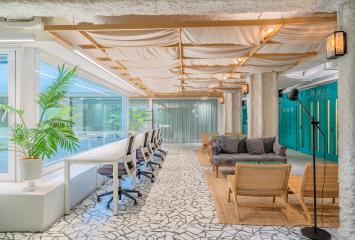Integrated decoration in architecture: where functionality meets aesthetics
In recent decades, and even over the past few centuries, architecture has shifted to become much more functional and significantly less ornamental, with the idea that interior design should be responsible for decorative elements. But in the past, things were different. Just look at ancient Greek, Roman, and medieval buildings, and you’ll see how decoration was often an integral part of the architecture itself, both inside and out. While today’s trend generally leans towards minimalism, there’s a growing revival of that holistic architectural approach from the past, incorporating certain key components.
Columns
Columns, by nature, are structural elements, meaning they serve a functional purpose. They’re designed to support the weight of upper structures in a building. Sometimes they’re hidden behind other structural components like walls, but frequently they’re left exposed. When visible, columns aren’t just structural; they can also be highly aesthetic. This is where the variety of column styles comes into play: the simple and robust Doric columns, the elegant and fluted Ionic columns, or the highly ornamental Corinthian columns. Each can add significant character and charm to an office space.
Vault
The same goes for vaults. These curved architectural elements are designed to provide structural support but can also serve as striking decorative features. From the semicircular barrel vault to the more intricate groin vault or the always-impressive ribbed vault, these structures offer a broad range of styles, each with unique geometric forms and physical principles, as well as opportunities for additional decorative detailing. Although vaults often come with a higher construction cost, they deliver a strong aesthetic impact that’s hard to replicate with other features.
Materials
Beyond structural components like columns and vaults, materials themselves play a critical role in bridging functionality and aesthetics. A great example, often seen in today’s industrial design trend, is leaving exposed brick walls in their raw state to create a distinctive visual style. In other instances, architecture firms opt for materials such as smooth cut stone, stone carved with intricate details, smooth stucco, textured stucco, or painted stucco to add layers of beauty and character to a space.
Ornamental Details
Sometimes, architectural elements might not serve a clear practical purpose but still add tremendous value in terms of elegance and style. Think of capitals adorning the tops of columns, cornices with decorative patterns, or friezes with sculpted reliefs or inscriptions running along the walls. Additionally, architects can enhance a space with embellishments like frescoes painted on wet plaster, wall sculptures that create depth, or mosaics made from materials like glass, stone, or ceramic, arranged in various artistic styles.
In essence, architecture that integrates decoration goes beyond just supporting a structure—it transforms spaces into aesthetically captivating environments. When thoughtfully designed, these elements can also reflect the culture, philosophy, and values of the time—something especially relevant for office buildings, which are an extension of a company’s corporate identity. Integrated decorative features can influence how we perceive space, light, and the overall atmosphere. It’s about more than just looks—it’s about creating meaningful, functional, and beautiful spaces.

